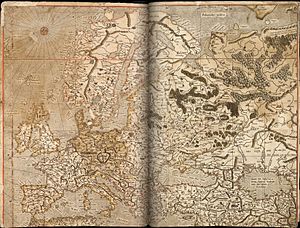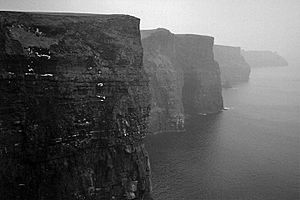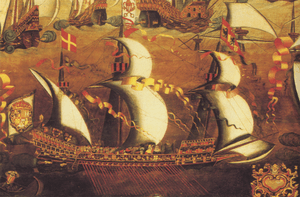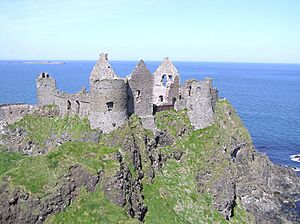Spanish Armada in Ireland facts for kids
The Spanish Armada in Ireland tells the story of what happened when a large fleet of Spanish ships, sent by King Philip II of Spain to invade England, ended up on the coast of Ireland in September 1588.
The Spanish fleet, known as the Armada, had 130 ships. After a big battle near Gravelines, the Armada tried to sail home through the North Atlantic. But huge storms pushed them off course, right towards the west coast of Ireland. The English government in Dublin, led by Queen Elizabeth I, was very worried. They ordered that any Spanish sailors who landed, and any Irish people who helped them, should be treated harshly.
About 24 Armada ships were wrecked along 500 kilometers of Ireland's rocky coastline, from Antrim in the north to Kerry in the south. The English quickly dealt with the threat. Many survivors from the shipwrecks were killed. Others managed to escape across the sea to Scotland. It's thought that around 6,000 Spanish sailors died in Ireland or off its shores.
Contents
Why the Armada Sailed
The Spanish Armada was a huge fleet of 130 ships. It left A Coruña in August 1588. Its main goal was to help a Spanish army from Flanders invade England. The Armada faced the English navy in the English Channel. A surprise attack with fire ships near Calais broke up their formation. Then, the Battle of Gravelines pushed them into the North Sea.
After this battle, 110 ships were still under the command of the Duke of Medina Sidonia. Many ships were damaged or low on supplies. This made them unfit for the long journey across the Atlantic Ocean. Some ships had even cut their anchors to escape the fire ships. This made it very hard for them to sail safely near the coast. Also, the Armada's leaders made a big mistake in their navigation. This brought the fleet too close to the dangerous Atlantic coasts of Scotland and Ireland.
The Difficult Journey Home
The Armada's sailing orders were almost impossible to follow. The weather was terrible, with strong winds and storms. Many ships and their crews were in great trouble. The maps used by the navigators were very basic. Their skills in dead reckoning (estimating position) and latitude sailing were not good enough. They couldn't guide the fleet safely home.
The Armada was supposed to sail around the north of Shetland. But on August 20, it passed south of Orkney and Fair Isle. This carried them into the Atlantic further south than planned. They were then meant to sail past North Uist in the Hebrides Islands and see the distant islet of Rockall. But they failed again. Strong southerly winds from August 21 to September 3 stopped the fleet from sailing west-south-west as ordered. One sailor wrote, "We sailed without knowing whither through constant fogs, storms and squalls."
The bad weather made the sailing orders useless. But a big mistake in calculating their position also led to disaster. The navigators didn't know about the Gulf Stream, a strong ocean current flowing east. This current must have slowed the fleet down, perhaps by as much as 30 kilometers a day. A paymaster on one ship, Marcos de Aramburu, kept a log. His notes suggest his ship's estimated position was wrong by about 480 kilometers. They thought they were far to the west, but they were actually much further east. This put them dangerously close to the coasts of Scotland and Ireland. This single error "made the difference between safety and disaster."
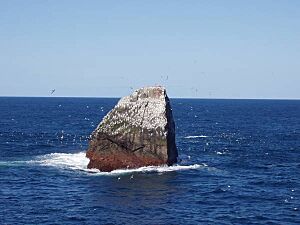
After seven weeks at sea, finding land to get supplies and make repairs would have been welcome. But sailing in these waters needed special knowledge. Spanish sailors usually only traded to the south and southwest of Ireland. So, the fleet's pilots probably wanted to stick to their original course, even with all the problems on board.
Most of the fleet, 84 ships, avoided land and made it home, though many were in bad shape. The rest, perhaps 28 ships, were forced towards the coast of Ireland. These included several large galleons and many merchant ships. These merchant ships had been changed for battle and were leaking badly. Their masts and rigging were damaged, and most had lost their anchors. The ships seemed to stay together until early September. Then, a strong southwest storm scattered them. An Irish official at the time called it a storm "the like whereof hath not been seen or heard for a long time." Within days, this lost part of the fleet landed in Ireland.
English Preparations in Ireland
The main English leader in Dublin was Lord Deputy William Fitzwilliam. In August 1588, he heard news that the Spanish had won the battle in the English Channel. He thought the invasion of England was about to happen. Then, he learned the Spanish were in the Atlantic and their whole fleet might land in Ireland. The English in Dublin were extremely worried. Fitzwilliam even spread false rumors that 10,000 English soldiers were coming as backup.
The English feared the Spanish would land in organized groups. They also worried that Irish people, especially those in areas not fully controlled by the English, would join the Spanish. But soon, reliable news reached Waterford and Dublin. It said the Spanish ships were landing in a messy way, scattered along 300 miles of coastline in Ulster, Connacht, and Munster. Fitzwilliam ordered that all Spanish sailors be captured and immediately hanged. He also said that anyone helping them would be tortured and charged as a traitor to the Queen.
Where the Ships Landed
Munster Coast
The Armada first reached the southern province of Munster. This area had been settled by the English in 1583.
County Clare: Many ships were seen off the coast of County Clare. Four were near Loop Head, and two of them were wrecked. This included the San Esteban (a 700-ton ship with 264 men) at Doonbeg. The damaged San Marcos (790 tons, 409 men) likely sank at Lurga Point. The sheriff of Clare, Boetius MacClancy, ordered all survivors to be killed.
Seven ships anchored at Scattery Roads. They probably had a pilot who knew the coast. Their landing party was fought off, but they did get some supplies and fix their ships. One large ship, Anunciada (703 tons, 275 men), was set on fire and sunk off Kilrush on September 12. Its crew moved to Barco de Danzig, which made it safely to Spain.
Blasket Islands: One Armada commander, Juan Martínez de Recalde, knew the Irish coast. In 1580, he had landed a force in the Dingle peninsula. In the Armada, he commanded the large ship San Juan de Portugal (1,150 tons, 500 men). This ship had fought bravely against the English fleet.
After the defeat at Gravelines, Recalde's ship led San Juan de Bautista (750 tons) and a small Scottish fishing boat. As they neared Kerry, Recalde's lookouts saw Mount Brandon and the rocky Blasket Islands. Recalde steered towards the islands to find shelter. He sailed through a narrow gap at the eastern tip of the Great Blasket Island. His ship reached calm water and anchored. The other two ships followed. This was a difficult move that needed local knowledge.
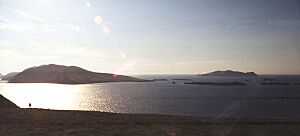
Recalde's ships stayed safe for several days. An English force arrived in Dingle to stop any landings. Recalde sent a small group ashore to explore, but all eight were captured. At one point, a westerly storm caused Portugal to crash into San Juan de Bautista. Later, another ship, Santa Maria de la Rosa (900 tons), entered the sound and fired a distress signal.
As the tide went out, Recalde's ships stayed anchored. But Santa Maria de la Rosa drifted and then sank, perhaps hitting Stromboli Rock. Only one person survived. He told the English that the captain had killed the pilot just as the ship sank. He also falsely claimed the Prince of Ascoli, the King of Spain's son, had died on board. This false information was useful for English propaganda.
Two more ships entered the sound. One, San Juan de Ragusa (650 tons), was in trouble and sank. San Juan de Bautista tried to leave the sound but struggled with the reefs. After a difficult night, the crew found themselves back at the entrance. But then the wind changed, and San Juan de Bautista finally escaped on September 25. It made it home to Spain after a terrible storm.
Three days later, Recalde led his remaining ships out of the sound and back to Spain. He died soon after. The survivors captured by the English were killed in Dingle.
Fenit: The small ship Nuestra Senora del Socorro (75 tons) anchored at Fenit, in Tralee Bay in Kerry. It surrendered to English officers. The 24 men on board were taken to Tralee Castle. By order of Lady Margaret Denny, they were all hanged.
Valentia Island: The Trinidad (800 tons) was wrecked on the coast of Desmond, probably at Valentia Island. Not many details are known about this event.
At Liscannor, the oar-powered ship Zuñiga (290 tons) anchored offshore. Its rudder was broken. It had found a gap in the Cliffs of Moher, which are over 220 meters high. The sheriff of Clare watched the ship. When a small boat went ashore for supplies, the Spanish were attacked by English forces and had to go back to their ship. One Spanish sailor was captured and questioned. Zuñiga managed to escape with good winds. It stopped at Le Havre and finally made it back to Naples the next year.
Ulster Coast
Donegal: La Trinidad Valencera (1,000 tons) was taking on too much water. As it neared the coast, it rescued 264 men from another ship, Barca de Amburgo, which was also sinking. Trinidad anchored in Glenagivney Bay. It tilted so much that the order was given to leave the ship. Locals were paid to use a small boat, and all 560 men were brought ashore over two days.
During a seven-day march inland, the survivors met English cavalry. They were promised safe passage if they surrendered to Fitzwilliam. The Spanish laid down their weapons. The noblemen and officers were separated. About 300 ordinary men were killed. The remaining 150 fled through the bog. Some ended up with Sorley Boy MacDonnell at Dunluce, others with Bishop Redmond O'Gallagher. They were then sent to Scotland. The 45 noblemen and officers were marched to Dublin, but only 30 survived. They were sent to London for ransom.
Three more ships, whose names are unknown, were wrecked on the Donegal coast. One was at Mullaghderg, another at Rinn a' Chaislean. The third was found in 2010 at Burtonport.
Antrim: The biggest loss of life happened when the ship La Girona sank. It had stopped for rudder repairs at Killybegs. There, 800 survivors from two other Armada shipwrecks boarded it. These were from La Rata Santa Maria Encoronada and Duquesa Santa Ana, which ran aground at Loughros Mor Bay, Donegal. La Girona set sail for Scotland. But on October 26, its rudder broke, and it was wrecked off Lacada Point, County Antrim. Out of an estimated 1300 people on board, only nine survived.
Connacht Coast
The Governor of Connacht, Richard Bingham, asked Dublin for more soldiers. But Fitzwilliam, who had few resources, said no. A public announcement made it treason, punishable by death, for anyone to help the Spanish. Many survivors from all over the province were brought to Galway. At first, 40 noblemen were kept for ransom, and 300 men were killed. Later, Fitzwilliam ordered that all unarmed noblemen, except two, be executed. Six Dutch boys who were captured later were also killed. In total, 12 ships were wrecked on the Connacht coast, and 1,100 survivors were put to death.
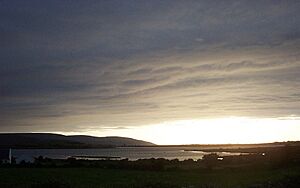
Galway: Falcon Blanco (300 tons) and Concepción de Juanes del Cano (225 men) and another unknown ship entered Galway Bay. Falcon Blanco ran aground at Barna, five kilometers west of Galway City. Most of its crew made it to shore. Concepción de Juanes del Cano ran aground at Carna, 30 kilometers further west. It had been lured to shore by bonfires lit by a group of wreckers from the Clan O'Flaherty.
Sligo: Three ships ran aground near Streedagh Strand, ten miles north of Sligo town. About 1,800 men drowned, and perhaps 100 made it ashore. The wreck site was found in 1985. Among the survivors was Captain Francisco de Cuellar, who wrote a famous account of his experiences.
- La Lavia (25 guns) was a Venetian merchant ship;
- La Juliana (32 guns) was a Catalan merchant ship; and
- Santa Maria de Vison (de Biscione) (18 guns) was a ship from Ragusa.
Mayo: In September, a large ship was wrecked at Tyrawley (modern County Mayo). There's a story that another ship was wrecked nearby, near Kid Island, but no official record exists. Also, Gran Grin was wrecked at the mouth of Clew Bay.
Among the ships wrecked in Connacht was the merchant ship La Rata Santa Maria Encoronada (419 men). It needed urgent repairs and sailed for the Irish coast with four other ships. La Rata Santa Maria Encoronada was skillfully sailed along the northern coast of Mayo. But it couldn't get past the Mullet Peninsula. So, it anchored in Blacksod Bay on September 7. The wind picked up, and the anchors dragged. The ship was driven onto Ballycroy strand. All the crew got to shore, led by Don Alonso Martinez de Leyva. They took over two castles and filled them with supplies from the beached ship, which was then burned. The son of an Irish rebel, Maurice Fitzmaurice, had died on board and was buried at sea.
The Spanish soon moved to another castle. There, they met many other survivors from another ship that had entered Broadhaven without masts. De Leyva's group now had 600 men. The governor of Connacht, Richard Bingham, decided not to fight them. After some days, two Armada ships entered Blacksod Bay: the merchant ship Nuestra Señora de Begoña (750 tons) and the transport ship Duquesa Santa Ana (900 tons). De Leyva and his 600 men boarded Duquesa Santa Ana. Nuestra Señora de Begoña sailed straight for Santander, Spain, arriving later. However, Duquesa Santa Ana was somewhat damaged. It was decided to sail north for Scotland. But stormy weather soon hit Duquesa Santa Ana, and it ran aground in Loughros Bay in Donegal. Everyone on board reached shore in what was friendly territory.
De Leyva, who was badly hurt, camped on the shore for nine days. Then, news came of another ship, the Girona, which had anchored in Killybegs harbor. Two other ships had been lost trying to enter that harbor. With help from an Irish chieftain, MacSweeney Bannagh, Girona was repaired. It set sail in mid-October with 1,300 men, including de Leyva. They cleared Lough Foyle, but then a storm hit. Girona was driven ashore at Dunluce in modern County Antrim. Only nine people survived. They were sent to Scotland by Sorley Boy MacDonnell. 260 bodies washed ashore.
Aran Islands: Two ships were seen off the Aran Islands. One failed to land a party in bad weather, and its fate is unknown.
Antrim Coast
The single biggest loss of life happened when the ship Girona was wrecked on the coast of Antrim. This was after it had taken on many survivors from other ships wrecked on the coast of Connacht (as mentioned above).
What Happened Next
Between 17 and 24 ships of the Spanish Armada were lost on the Irish coast. This was about one-third of the fleet's total loss of 63 ships. Around 6,000 men died.
By the end of September 1588, Fitzwilliam told the Queen's secretary, Lord Burghley, that the Armada threat was over. Soon after, he thought only about 100 survivors remained in Ireland. In 1596, an envoy from Philip II came to Ireland to find survivors. He only found eight.
After the Armada's defeat, the English sent their own fleet against Spain. But they failed to win a clear victory and returned with huge losses. During the Anglo-Spanish War, the Spanish landed 3,500 soldiers in southern Ireland. This was to help the Irish rebel leader Hugh O'Neill during the Nine Years' War (1594–1603). This Spanish mission also failed. Spain and England made peace in 1604.
By the time of the peace, Spain had regained its strength at sea. Gold and silver from the New World flowed into their treasury at a faster rate. Elizabeth's successor, James I, didn't focus on his navy. Instead, he worked to strengthen English control in Ireland. In 1607, the Irish lords of Ulster fled to Europe. The English conquest of Ireland was mostly finished when their lands were taken and settled in the Plantation of Ulster in 1610.
There is a popular story that the Spanish Armada left descendants in Ireland. However, research has shown that these claims are not true.
Salvage Efforts
The first attempts to recover items from the shipwrecks happened within months. George Carew tried on the coast of County Clare. He complained about the cost of giving the divers lots of whiskey!
Sorley Boy MacDonnell recovered three brass cannons and two chests of treasure from the wreck of Girona.
In 1797, some lead and brass guns were raised from an unknown Armada ship wreck at Mullaghderg in County Donegal. Two miles south of there, in 1853, an anchor was found from another unknown Armada wreck.
The Spanish Armada in Art
The Grainuaile Suite (1985) is a musical piece by Irish composer Shaun Davey. It tells the story of the Irish sea-queen Gráinne O'Malley. It includes a sad song about the Spanish landings in Ireland, sung by Rita Connolly.
The sinking of La Girona is shown in pictures of the Armada and the Antrim coast. These pictures appear on the back of sterling banknotes issued by the First Trust Bank in Northern Ireland.
The last novel by Anthony Burgess, Byrne: A Novel, features a main character who is said to be descended from Spanish survivors who stayed in Ireland.
The American films The Luck of the Irish and Darby O'Gill and the Little People mention the Spanish Armada shipwrecks. They use this as a reason for leprechauns having pots of gold.
The Spanish-Portuguese short animated film The Monkey (2021) was inspired by the story of The Hartlepool Monkey. It focuses on how Spanish shipwreck survivors were treated on Irish shores. The film, starring Colm Meaney, won the Goya for best Best Animated Short Film in 2021.
Images for kids
-
Rockall, a small, isolated rocky islet in the North Atlantic Ocean about 430 kilometres (270 mi) north-west of Donegal.
-
Recalde sailed through the gap between the tip of the Great Blasket and Carraig Fhada (right-of-centre) to enter the sound (foreground). Look-outs for the crown army would have shared this clifftop view from the Dingle peninsula.
-
Galway Bay near County Clare.
See Also
- List of shipwrecks in the 16th century
- Girona (ship)
- Hugo of Moncada i Gralla
Sources


